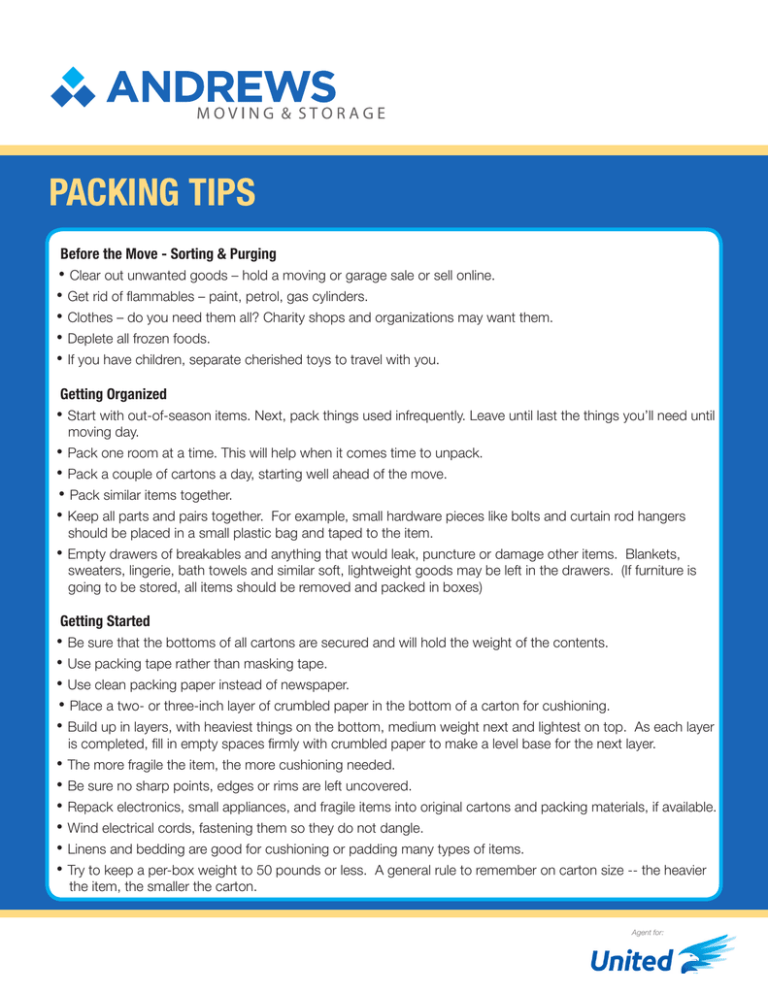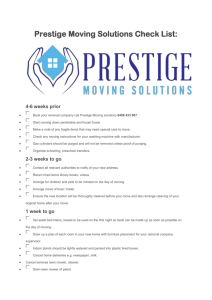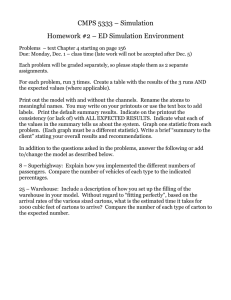packing tips - Andrews Moving
advertisement

Identity Andrews Moving and Storage is a full s the experience and technology to mak over 100 years of experience Andrews operates full service facilities in both S has become one of the largest and mo companies in the entire United States. PACKING TIPS Commitment As a locally owned and operated busin of our community. We promise that: • Clear out unwanted goods – hold a moving or garage sale or sell online. • Each of us will use our skills to ensure • Get rid of flammables – paint, petrol, gas cylinders. • We will provide the highest level of p • Clothes – do you need them all? Charity shops and organizations may want •them. We will strive for growth and effectiv • We will foster an atmosphere of pers • Deplete all frozen foods. Before the Move - Sorting & Purging • If you have children, separate cherished toys to travel with you. Getting Organized Quality Through constant examination of our p • Start with out-of-season items. Next, pack things used infrequently. Leave until last the things you’ll need until the best in customer service practices. carefully reviewed. We will go the extra • Pack one room at a time. This will help when it comes time to unpack. • President’s Award Winner - Awarded • Pack a couple of cartons a day, starting well ahead of the move. quality scores • Pack similar items together. • Multiple Customer Choice Award Win • Keep all parts and pairs together. For example, small hardware pieces like bolts and curtain rod hangers moving day. should be placed in a small plastic bag and taped to the item. • Empty drawers of breakables and anything that would leak, puncture or damage other items. Blankets, sweaters, lingerie, bath towels and similar soft, lightweight goods may be left in the drawers. (If furniture is going to be stored, all items should be removed and packed in boxes) Vision We display our commitment to growth Getting Started technology and service-driven initative • Be sure that the bottoms of all cartons are secured and will hold the weight ofcontinue the contents. to strive for profitable growth • Use packing tape rather than masking tape. abroad. • Use clean packing paper instead of newspaper. • Place a two- or three-inch layer of crumbled paper in the bottom of a carton for cushioning. • Build up in layers, with heaviest things on the bottom, medium weight next and lightest on top. As each layer is completed, fill in empty spaces firmly with crumbled paper to make a level base for the next layer. Leverage • The more fragile the item, the more cushioning needed. • Be sure no sharp points, edges or rims are left uncovered. As a member of the world’s largest van • Repack electronics, small appliances, and fragile items into original cartons and packing if available. United Van materials, Lines, along with its sister v • Wind electrical cords, fastening them so they do not dangle. relocation industry market share. We a • Linens and bedding are good for cushioning or padding many types of items.allowing us to offer the best of both wo • Try to keep a per-box weight to 50 pounds or less. A general rule to remember on carton size -- the heavier the item, the smaller the carton. Agent for: Labeling and Sealing Cartons • As you finish with each carton, list the contents on the side of the carton (for easy viewing while cartons are stacked). • On the SIDE of each carton, write your name, date and the room to which each carton should be delivered at your new residence. • Label cartons you want to unpack first with LAST ON, FIRST OFF. • All boxes with “fragile” items should be marked accordingly. • ALL boxes must be closed and sealed tightly with tape. • EXCEPTION: Leave cartons open that contain items listed on United’s High-Value Inventory form. These must be left open for the van operator’s inspection. Packing Basics • Barbecue Grills and Propane Tanks - Wrap grates and briquettes separately in packing paper (or place all briquettes into a grocery bag) and place parts in carton. Pad carton with paper to reduce movement of contents. - Propane tanks cannot be transported in our moving trucks. • Books - Pack them in a small carton either flat or with the spine touching the bottom of the carton. - Pack books of the same general size together. - Expensively bound volumes or those of special sentimental value should be individually wrapped before packing. • China, Dishes and Glassware - Use a dish pack -- an exceptionally sturdy corrugated carton of double-wall construction — for china, glassware and other fragile items. - Wrap all pieces of china and glassware individually in packing paper. Using several sheets of paper, start from the corner, wrapping diagonally and continuously tucking in overlapping edges. A double layer of packing paper serves well as an outer wrapping. Place these bundled items in the carton in a row on edge. - Stuff glasses and stem ware with crumpled tissue or packing paper before wrapping. Corrugated paper rolls or cellular boxes may be used for added protection. - Place glasses and stem ware toward the top of your box. Heavier items (dishware, pitchers, etc.) should be placed toward the bottom of the box. - Delicate glassware and stem ware should be placed in an upright position, not on its side. - Stand shallow bowls (soup plates, etc.) on edge in the carton and deep ones (such as mixing bowls) nested two or three together, upside down on their rims. - A generous amount of paper padding and cushioning is required for all china and glassware. Label cartons, “FRAGILE — THIS SIDE UP.”

